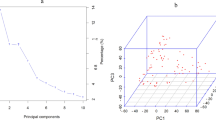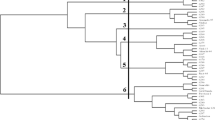Abstract
Rice is one of staple food crops in the world. Improving the drought tolerance of rice has become an important issue for maintaining or increasing its grain production under water stress caused by the greenhouse effect. For achieving this goal, quantitative trait loci (QTL) mapping is considered to be useful in plant breeding. In this study, a doubled-haploid (DH) population was used as elite materials. Based on results of polymorphism detection, 108 polymorphic markers were identified. The mapping analysis results indicated that 40 QTLs putatively associated with seven traits were found in nine linkage groups.


Similar content being viewed by others
References
Bai X, Luo L, Yan W, Kovi MR, Zhan W, Xing Y (2010) Genetic dissection of rice grain shape using a recombinant inbred line population derived from two contrasting parents and fine mapping a pleiotropic quantitative trait locus qGL7. BMC Genet 11:16–16
Becker J, Vos P, Kuiper M, Salamini F, Heun M (1995) Combined mapping of AFLP and RFLP markers in barley. Mol Gen Genet 249:65–73
Bhattarai U, Subudhi PK (2018) Genetic analysis of yield and agronomic traits under reproductive-stage drought stress in rice using a high-resolution linkage map. Gene 669:69–76
Borah P, Sharma E, Kaur A, Chandel G, Mohapatra T, Kapoor S, Khurana JP (2017) Analysis of drought-responsive signalling network in two contrasting rice cultivars using transcriptome-based approach. Sci Rep 7:42131
Chen MY, Ali J, Fu BY, Xu JL, Zhao MF, Jiang YZ, Zhu LH, Shi YY, Yao DN, Gao YM, Li ZK (2011) Detection of drought-related loci in rice at reproductive stage using selected introgressed lines. Agric Sci China 10:1–8
Chen QF, Wang CL, Lu YM, Shen M, Afza R, Duren MV, Brunner H (2001) Anther culture in connection with induced mutations for rice improvement. Euphytica 120:401–408
Harushima Y, Yano M, Shomura A, Sato M, Shimano T, Kuboki Y, Yamamoto T, Lin SY, Antonio BA, Parco A, Kajiya H, Huang N, Yamamoto K, Nagamura Y, Kurata N, Khush GS, Sasaki T (1998) A high-density rice genetic linkage map with 2275 markers using a single F2 population. Genetics 148:479–494
He T, Yang Y, Tu SB, Yu MQ, Li XF (2006) Selection of interspecific hybrids for anther culture of indica rice. Plant Cell Tissue Organ Cult 86:271–277
Herath H, Bandara D, Samarajeewa P (2007) Effect of culture media for anther culture of indica rice varieties and hybrids of indica and japonica. Trop Agric Res Ext 10:17–22
Huang B, Keller WA (1989) Microspore culture technology. J Tissue Cult Methods 12:171–178
Huang N, McCouch S, Mew T, Parco A, Guiderdoni E (1994) Development of an RFLP map from a doubled haploid population in rice. Rice Genet News 11:134–137
Jongdee B, Fukai S, Cooper M (2002) Leaf water potential and osmotic adjustment as physiological traits to improve drought tolerance in rice. Field Crops Res 76:153–163
Joshi R, Wani SH, Singh B, Bohra A, Dar ZA, Lone AA, Pareek A, Singla-Pareek SL (2016) Transcription factors and plants response to drought stress: current understanding and future directions. Front Plant Sci 7:1029–1029
Lafitte HR, Price AH, Courtois B (2004) Yield response to water deficit in an upland rice mapping population: associations among traits and genetic markers. Theor Appl Genet 109:1237–1246
Lee SY, Lee JH, Kwon TO (2003) Selection of salt-tolerant doubled haploids in rice anther culture. Plant Cell Tissue Organ Cult 74:143–149
Liu E, Liu Y, Wu G, Zeng S, Tran Thi TG, Liang L, Liang Y, Dong Z, She D, Wang H, Zaid IU, Hong D (2016) Identification of a candidate gene for panicle length in rice (Oryza sativa L.) via association and linkage analysis. Front Plant Sci 7:596–596
Lorieux M, Petrov M, Huang N, Guiderdoni E, Ghesquière A (1996) Aroma in rice: genetic analysis of a quantitative trait. Theor Appl Genet 93:1145–1151
Luo ZX, Wu R (1988) A simple method for the transformation of rice via the pollen-tube pathway. Plant Mol Bio Rep 6:165–174
Lo J, Lin G, Hou F (2009) Development of a new japonica rice variety “Tainan 13”. Res Bull of Tai Dist Agric Res and Ext Sta 54:1–13 (in Chinese with an English abstract)
Maheswaran M, Subudhi PK, Nandi S, Xu JC, Parco A, Yang DC, Huang N (1997) Polymorphism, distribution, and segregation of AFLP markers in a doubled haploid rice population. Theor Appl Genet 94:39–45
Mishra R, Rao GJN, Rao RN, Kaushal P (2015) Development and characterization of elite doubled haploid lines from two indica rice hybrids. Rice Sci 22:290–299
Murray MG, Thompson WF (1980) Rapid isolation of high molecular weight plant DNA. Nucleic Acids Res 8:4321–4325
Nandi S, Subudhi PK, Senadhira D, Manigbas NL, Sen-Mandi S, Huang N (1997) Mapping QTLs for submergence tolerance in rice by AFLP analysis and selective genotyping. Mol Gen Genet 255:1–8
Nguyen H, Chen XY, Jiang M, Wang Q, Deng L, Zhang WZ, Shu QY (2016) Development and molecular characterization of a doubled haploid population derived from a hybrid between japonica rice and wide compatible indica rice. Breed Sci 66:552–559
Nikaido A, Yoshimaru H, Tsumura Y, Suyama Y, Murai M, Nagasaka K (1999) Segregation distortion for AFLP markers in Cryptomeria japonica. Genes Genet Syst 74:55–59
Orjuela J, Garavito A, Bouniol M, Arbelaez JD, Moreno L, Kimball J, Wilson G, Rami JF, Tohme J, McCouch SR, Lorieux M (2010) A universal core genetic map for rice. Theor Appl Genet 120:563–572
Raina SK, Zapata FJ (1997) Enhanced anther culture efficiency of indica rice (Oryza sativa L.) through modification of the culture media. Plant Breed 116:305–315
Ramchander S, Raveendran M, Robin S (2016) Mapping QTLs for physiological traits associated with drought tolerance in rice (Oryza Sativa L.). J Investig Genom 3:56–61
Saji KV, Sujatha M (1998) Embryogenesis and plant regeneration in anther culture of sunflower (Helianthus annuus L.). Euphytica 103:1–7
Shamasbi FV, Jamali SH, Behzad S, Babak AM (2017) Genetic mapping of quantitative trait loci for yield-affecting traits in a barley doubled haploid population derived from Clipper × Sahara 3771. Front Plant Sci 8:1–9
Son YJ, Lee GH, Lee HS, Handoyo T, Yun BW, Kim KM (2014) Analysis of high-resolution QTL markers associated with rice yields using data for two consecutive years in different environmental conditions. Nat Sci 6:818–827
Spada A, Caporali E, Marziani G, Portaluppi P, Restivo FM, Tassi F, Falavigna A (1998) A genetic map of Asparagus officinalis based on integrated RFLP, RAPD and AFLP molecular markers. Theor Appl Genet 97:1083–1089
Subudhi PK, Huang N (1999) RAPD mapping in a doubled haploid population of rice (Oryza Sativa L.). Hereditas 130:41–49
Virk PS, Ford-lloyd BV, Newbury HJ (1998) Mapping AFLP markers associated with subspecific differentiation of Oryza sativa (rice) and an investigation of segregation distortion. Heredity 81:613–620
Vos P, Hogers R, Bleeker M, Reijans M, van de Lee T, Hornes M, Frijters A, Pot J, Peleman J, Kuiper M (1995) AFLP: a new technique for DNA fingerprinting. Nucleic Acids Res 23:4407–4414
Wang JP, Bughrara SS, Nelson CJ (2008) Morpho-physiological responses of several fescue grasses to drought stress. Am Soc Hortic Sci 43:776–783
Williams JG, Kubelik AR, Livak KJ, Rafalski JA, Tingey SV (1990) DNA polymorphisms amplified by arbitrary primers are useful as genetic markers. Nucleic Acids Res 18:6531–6535
Xu Q, Yuan XP, Yu HY, Wang YP, Tang SX, Wei XH (2011) Mapping QTLs for drought tolerance at seedling stage in rice using doubled haploid population. Rice Sci 18:23–28
You A, Lu X, Jin H, Ren X, Liu K, Yang G, Yang H, Zhu L, He G (2006) Identification of quantitative trait loci across recombinant inbred lines and testcross populations for traits of agronomic importance in rice. Genetics 172:1287–1300
Zaman NK, Abdullah MY, Othman S, Zaman NK (2018) Growth and physiological performance of aerobic and lowland rice as affected by water stress at selected growth stages. Rice Sci 25:82–93
Zeng YX, Xia LZ, Wen ZH, Ji ZJ, Zeng DL, Qian Q, Yang CD (2015) Mapping resistant QTLs for rice sheath blight disease with a doubled haploid population. J Integr Agric 14:801–810
Zhao B, Deng QM, Zhang QJ, Li JQ, Ye SP, Liang YS, Peng Y, Li P (2006) Analysis of segregation distortion of molecular markers in F2 population of rice. Acta Genet Sin 33:449–457
Author information
Authors and Affiliations
Corresponding author
Supplementary Information
Below is the link to the electronic supplementary material.
Rights and permissions
About this article
Cite this article
Wongchuwech, P., Chen, RK. & Chang, YL. Mapping quantitative trait loci underlying drought-related traits in rice using a doubled-haploid population. CEREAL RESEARCH COMMUNICATIONS 50, 245–252 (2022). https://doi.org/10.1007/s42976-021-00187-5
Received:
Accepted:
Published:
Issue Date:
DOI: https://doi.org/10.1007/s42976-021-00187-5




